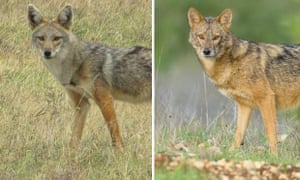
According to the authors, two golden jackal populations -- one in Eurasia and the other in Africa -- split more than one million years ago, which is sufficient to formally recognise each as separate species. Further, after exhaustive DNA analyses, the authors were surprised to learn that African golden jackals are more closely related to grey wolves, even though there are no grey wolves in Africa and even though grey wolves and African golden jackals look dramatically different. Adding to the confusion, African golden jackals are strikingly similar in appearance to their more distant relative, the Eurasian golden jackal. This strong physical similarity has long been the source of confusion over these animals’ taxonomy and evolutionary relationships.
As a result of this study, the authors propose that the African golden jackal be renamed as the African golden wolf, Canis anthus.
The evolutionary relationships of canids are poorly understood
The evolutionary relationships, or phylogenetics, of jackals have long been a mess, according to Adam Hartstone-Rose, an Associate Professor of Cell Biology and Anatomy at the University of South Carolina School of Medicine, who was not part of the study. Traditionally, most taxonomists have recognised three jackal species: the black-backed, side-striped and golden jackals -- all of which live in Africa, with the golden jackal also ranging throughout much of Eurasia.“The three ‘species’ were considered close relatives based mostly on their similar body size and morphology”, explained Professor Hartstone-Rose in email.
“However, as the first molecular analyses of canids became available, it was obvious that ‘jackals’ are only similar based on amazing morphological convergences”, said Professor Hartstone-Rose. “The side-striped and black-backed species (historically called Canis adustus and C. mesomelas respectively) turn out to have split off of the stem of the large Canis group before the highly derived hunting dogs (Lycaon) and dholes (Cuon).”
Two earlier studies reported that golden jackals found in Africa are more closely related to grey wolves than to the golden jackals found in Eurasia (doi:10.1371/journal.pone.0016385 & doi:10.1371/journal.pone.0042740). These studies inspired Klaus Koepfli, a Research Associate and Visiting Scientist at the Center for Species Survival (CSS), which is part of the Smithsonian Conservation Biology Institute, to investigate more thoroughly.
“Those studies had only used one kind of genetic marker, sequences from the mitochondrial genome, which are only inherited through the maternal lineage”, explained Dr Koepfli in email.
“[E]volutionary history is best verified through concordance among genetic markers from across the genome that are inherited maternally, paternally and bi-parentally and that evolve at different rates to capture different stages of divergence. Therefore, we wanted to test the conclusions of the two previous studies by adding data from the nuclear genome”, said Dr Koepfli.
African and Eurasian golden jackals are genetically distinct
The researchers started by generating new sequence data (sampling sites are indicated with red dots in Figure 1B) for canid cytochrome b, a gene in the mitochondrial genome, and combined them with sequences from the two previously published studies (doi:10.1371/journal.pone.0016385 & doi:10.1371/journal.pone.0042740). Their analysis of these data incorporated a total of 104 cytochrome b sequences (1,140 bp each) to reconstruct a phylogeny (Figure 1A), for golden jackals from both Africa and Eurasia:This mitochondrial gene tree indicates that the African golden jackal is more closely related to the Eurasian gray wolf, and is distantly related to the Eurasian golden jackal (with up to 6.7 percent divergence).
“In fact, golden jackals from different localities in Africa share a more recent common ancestry with gray wolves”, said Dr Koepfli.
The team then conducted another analysis using a more comprehensive array of molecular markers that are inherited from both parents. All of these DNA markers consisted of fragments of 20 chromosomal, or nuclear, genes sampled from throughout the genome. These markers consistently showed that golden jackals are separated into two well-supported clades, as seen in this time tree, or chronogram (Figure 2):

“We found that the African golden jackal lineage split from gray wolves plus coyotes about 1.3 million years ago. The Eurasian golden jackal lineage, however, split about 600,000 years prior to that”, said Dr Koepfli.
Not only does the chromosomal (nuclear) DNA data phylogeny suggest a close relationship between African golden jackals and grey wolves, but if you look carefully, you will also notice that it indicates that the Eurasian golden jackal split away from from the grey wolf long before grey wolves and coyotes diverged.
“If African and Eurasian golden jackals belonged to the same species, we would expect these two groups to be more closely related (share common ancestry)”, said Dr Koepfli.
Multiple DNA markers show African and Eurasian golden jackals are different
The researchers continued their investigation by analysing additional molecular markers: sex chromosome sequences (Figure 3A); tiny variations in the DNA sequence known as single nucleotide polymorphisms (SNPs; pronounced “snips”) sampled from across the genome in representative individuals (one golden jackal from Kenya, one golden jackal from Israel and three grey wolves from different localities in Eurasia) (Figure 3B); and in microsatellites (long tracts of non-coding DNA comprised of short tandem repeating sequences), which are DNA markers that represent different samples of the genome from SNPs and which evolve differently than SNPs (Figure 3D):“The consistency of divergence between the two jackal lineages across the suite of molecular markers used in our study provides compelling evidence that the two lineages represent different species”, said Dr Koepfli.
The research team also tested genome-wide SNPs data to see whether African and Eurasian golden jackals show evidence of hybridisation with each other, or with wolves and dogs (Figure 3C).
“[W]e did detect signals of hybridization between the gray wolf/domestic dog lineage and the Eurasian golden jackal and African golden wolf lineages. However, that signal was much stronger in the Eurasian golden jackal lineage”, said Dr Koepfli.
“The individual we used for the genome-wide data came from Israel, where these golden jackals overlap with gray wolves and (feral) domestic dogs, so finding a strong signal of past hybridization is not too surprising”, said Dr Koepfli.
But African and Eurasian golden jackals look very very similar
Despite their distinct genetic ancestries, African and Eurasian golden jackals look so much alike that most scientists classified them as the same species. Thus, the research team wanted to see if their genetic findings were reflected in the skull and tooth morphologies of African and Eurasian golden jackals. They analysed 45 different skull and tooth characteristics from more than 140 golden jackals from five different geographic regions across Africa and Eurasia (east Africa = red circles; north African = green circles; Middle East = blue triangles; Eurasia = grey triangles; central and west Africa = grey circles; Figure 4A):Analyses of these morphometric data revealed that despite their genetic distance, the golden jackals have a strong resemblance to each other, as revealed by these overlapping data clusters (east Africa = red circles; north African = green circles; Middle East = blue triangles; Figure 4B). These data certainly explain the difficulty in recognising golden jackals as separate species:
“Since the two jackal lineages are not closely related, this morphological similarity may be due to parallel evolution, driven by the ecological circumstances in which these animals live, especially with regards to the competition from other carnivore species”, said Dr Koepfli.
Parallel evolution is the development of a similar trait in related, but distinct, species that share a common ancestor. This differs from convergent evolution, where species with different evolutionary histories independently evolve traits that are similar in form or function (such as wings in flying insects, bats and birds) due to similar ecological demands.
Jackals may have more surprises in store for us
Since they have such an extensive range, golden jackals may comprise yet more cryptic species. Already, Dr Koepfli and his team are collecting preliminary genetic data from some populations of Eurasian golden jackals throughout Eurasia and they plan to do the same for the African golden jackals.“However, we need more comprehensive geographic sampling to better understand the population genetics and phylogeography of the two lineages.”
The golden jackals are only distantly related to the other two African jackal species, even though they are all placed into the same genus.
“In fact, phylogenetic results of nuclear DNA sequences shows that black-backed and side-striped jackals are each other’s closest relative and very distant from Eurasian golden jackals and African golden wolves”, said Dr Koepfli.
“All these are currently classified in the genus Canis, but this needs to be changed to reflect the distinct position of the clade that includes black-backed and side-striped jackals. This is something we’re currently working on.”
African golden jackals renamed African golden wolves
This painstaking work shines a powerful light on the convoluted relationship between ecology and evolution, and reveals how ecology can lead to confusion amongst even the most astute experts when it comes to identifying species. Further, these findings demonstrate why it is critical to analyse living species from all perspectives -- anatomic, behavioral, ecological and genetic -- in order to truly understand the evolution of those species.“This study demonstrates convincingly, using multiple lines of genomic evidence, that African and Eurasian golden jackals represent distinct lineages deserving of species-level separation”, said vertebrate paleontologist Jack Tseng from the American Museum of Natural History, who was not part of this study.
“The fascinating conclusion of parallelism in the African and Eurasian jackals gained from considering both molecular and anatomical evidence attests to the success of dogs such as Canis in colonizing and adapting to new environments”, said Dr Tseng.
“Within eastern Africa where I do most of my work, all canids (not just golden jackals) are relatively rare in the fossil record. Therefore, this study provides us with an intriguing glimpse of carnivore evolution that we might not otherwise know about”, said vertebrate paleontologist, Margaret Lewis, a Professor of Biology at Stockton University, who was not part of this study.
This research also has important conservation implications. For example, as established here, one widespread species may actually be several cryptic species.
“What if your two new species represented vastly different percentages of the former species? One of the new species could be doing relatively well while the other population is on the verge of extinction”, said Professor Lewis in email.
Currently, golden jackals (Eurasian and African) are listed by the IUCN as of Least Concern, but this assessment was made in 2008, before any of the recent genetic work on this group.
“While they are considered to be fairly common (particularly in Asia), it will be interesting to see if African golden wolves and Eurasian golden jackals will each retain this ranking in the next assessment. Jackals in general are declining as traditional land use practices disappear and are replaced by industrialization and urbanization. All jackals and jackal-like animals, not just African golden wolves, play a critical role in the ecology of their respective habitats”, said Professor Lewis.
“Hopefully, this research will raise awareness of the importance of jackals and similar species around the world before it is too late”, said Professor Lewis.
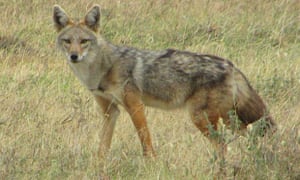
“We propose that the African golden jackal be re-named the African golden wolf and the scientific name be Canis anthus,” said Dr Koepfli.
This scientific name was first proposed in 1820 by Frédéric Cuvier in his description of this species.
Source:
Klaus-Peter Koepfli, John Pollinger, Raquel Godinho, Jacqueline Robinson, Amanda Lea, Sarah Hendricks, Rena M. Schweizer, Olaf Thalmann, Pedro Silva, Zhenxin Fan, Andrey A. Yurchenko, Pavel Dobrynin, Alexey Makunin, James A. Cahill, Beth Shapiro, Francisco Álvares, José C. Brito, Eli Geffen, Jennifer A. Leonard, Kristofer M. Helgen, Warren E. Johnson, Stephen J. O’Brien, Blaire Van Valkenburgh,and Robert K. Wayne. (2015). Genome-wide Evidence Reveals that African and Eurasian Golden Jackals Are Distinct Species, Current Biology, published online on 30 July 2015 ahead of print | doi:10.1016/j.cub.2015.06.060Grrlscientist sincerely thanks Klaus-Peter Koepfli, Jack Tseng, Adam Hartstone-Rose, and Margaret Lewis for sharing their expertise, excitement and insights into the nuances of this research.
Also cited:
Eli Knispel Rueness, Maria Gulbrandsen Asmyhr, Claudio Sillero-Zubiri, David W. Macdonald, Afework Bekele, Anagaw Atickem, Nils Chr. Stenseth. (2011). The cryptic African wolf: Canis aureus lupaster is not a golden jackal and is not endemic to Egypt, PLoS ONE 6, e16385 | doi:10.1371/journal.pone.0016385 (OA)
Philippe Gaubert, Cécile Bloch, Slim Benyacoub, Adnan Abdelhamid, Paolo Pagani, Chabi Adéyèmi Marc Sylvestre Djagoun, Arnaud Couloux, Sylvain Dufour (2012). Reviving the African Wolf Canis lupus lupaster in north and west Africa: A mitochondrial lineage ranging more than 6,000 km wide, PLoS ONE 7, e42740 | doi:10.1371/journal.pone.0042740 (OA)
Kerstin Lindblad-Toh , Claire M Wade, Tarjei S. Mikkelsen, Elinor K. Karlsson, David B. Jaffe, Michael Kamal, Michele Clamp, Jean L. Chang, Edward J. Kulbokas III, Michael C. Zody, et al. (2005). Genome sequence, comparative analysis and haplotype structure of the domestic dog, Nature 438, 803-819 (8 December 2005) | doi:10.1038/nature04338 (OA)
source


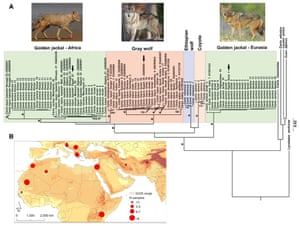

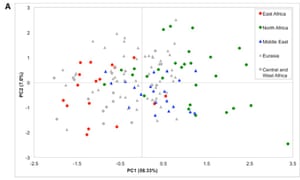

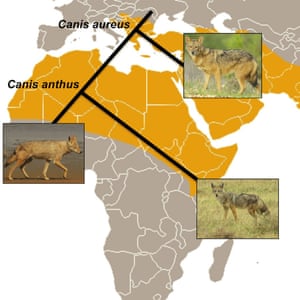
No comments:
Post a Comment